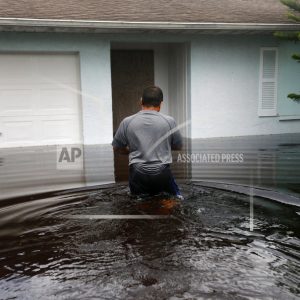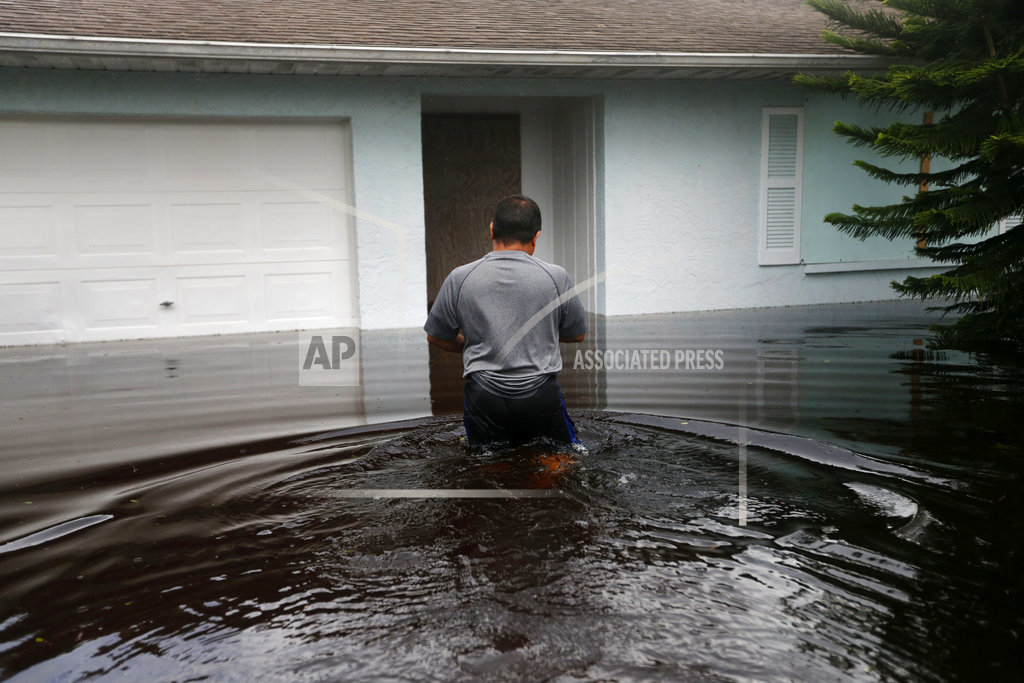
TAMPA, Florida (AP) — Hurricane Irma weakened into a still-dangerous tropical storm Monday as it pushed inland, triggering record flooding in Florida’s northeastern corner, while rescuers in its soggy, wind-battered wake mobilized to reach victims and learn the full extent of the damage.
The storm engulfed nearly the entire Florida peninsula, wreaking havoc from the state’s southernmost point up to the Georgia line, from the Atlantic coast to the Gulf side. It swamped homes, uprooted massive trees, flooded streets, cast boats ashore, snapped miles of power lines and toppled construction cranes.
“How are we going to survive from here?” asked Gwen Bush, who waded through thigh-deep floodwaters outside her central Florida home to reach National Guard rescuers and get a ride to a shelter. “What’s going to happen now? I just don’t know.”
More than 6.2 million homes and businesses remained without power, and 220,000 people huddled in shelters. Officials warned it could take weeks for electricity to be restored to everyone.
No deaths in Florida were immediately linked to the storm. At least 34 people were killed in the Caribbean as Irma ravaged a string of resort islands long known as vacation playgrounds for the rich.
Irma’s wrath in the Sunshine State stretched hundreds of miles.
In the Keys, where the storm roared ashore Sunday morning with winds of 130 mph (209 kph), search crews planned door-to-door checks on residents. In Coral Gables, near Miami, fallen trees made streets look like jungles, and damaged power lines buzzed. In Estero near the state’s southwest corner, people sat in puddles in a crowded arena-turned-shelter.
And more than 400 miles from where Irma first came ashore, storm surge brought flooding to the Jacksonville area at levels not seen in more than 50 years, with at least 46 people pulled from swamped homes.
“Stay inside unless you are in danger,” forecasters warned.
The full breadth of the damage statewide remained unknown, though, with communications and travel cut off by high winds and flooding.
As of midmorning, Irma’s outer bands were also blowing into Georgia, where the storm’s center was expected to arrive later in the day. From there, Irma is expected to push into Alabama, Mississippi and Tennessee on Tuesday and Wednesday.
A tropical storm warning was issued for the first time ever in Atlanta, and school was canceled in communities around the state. More than 100,000 were without power in Georgia.
The monster storm arrived in Florida a fearsome Category 4 hurricane but soon weakened. By Monday morning, Irma was downgraded to a tropical storm, with winds of 65 mph (110 kph).
People in the heavily populated Tampa-St. Petersburg area were braced for its first direct hit from a major hurricane since 1921. But by the time it struck in the middle of the night Monday its winds were 100 mph (161 kph) or less.
Tampa Mayor Bob Buckhorn said the situation was not as bad as it could have been but warned residents that dangerous storm surge continued. He also reported downed power lines and other debris.
“What we feared the most was the surge,” he said on MSNBC. “The surge is yet to be finished.”
In Redington Shores west of Tampa, Carl Roberts spent a sleepless night riding out Irma in his 17th-floor beachfront condo. After losing power late Sunday, he made it through the worst of the storm shaken but unhurt.
“The hurricane winds lashed the shutters violently, throughout the night,” he wrote in a text message, “making sleep impossible.”
As morning broke, he couldn’t open the electric shutters to see outside.
Video from the Keys showed a pickup truck zig-zagging over the center line to avoid several boats tossed onto the asphalt. Nearby, houses were shoved from their foundations, and trees and other debris blocked a road.
East of Tampa, winds knocked a utility pole and power lines onto a sheriff’s cruiser late Sunday in Polk County. A deputy and a paramedic, who had just escorted an elderly patient to safety, were trapped for two hours until a crew could free them. Both were unhurt.
And more than 120 homes were being evacuated early Monday in just outside Orlando as floodwaters started to pour in. Firefighters and National Guardsmen went door-to-door and used boats to ferry families to safety.
A few miles away, 30 others had to be evacuated when a 60-foot sinkhole opened up under an apartment building. No injuries were reported.
___
Associated Press writers Seth Borenstein in Washington; Terry Spencer in Palm Beach County; Gary Fineout in Tallahassee; Terrance Harris and Claire Galofaro in Orlando; and Jason Dearen and David Fischer in Miami contributed to this report.



